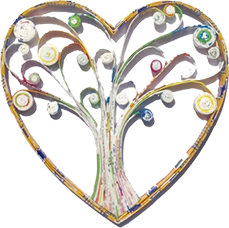Through mindfulness, we have the opportunity to become more aware of this impermanence.
Here is an example of a mindfulness practice that can help us accept change. We begin by bringing awareness to our body. Reflect on what our body is made of – skin, blood, bones, and organs. Then think about how these parts of our body in turn are made up of yet smaller parts, such as cells. These cells are moving, changing, reproducing, and dying. On that cellular level, we have constant change and movement. Our cells are made of atoms, subatomic particles and so forth. We can take time to appreciate this energy and movement within our body.
Even when we are sitting still, we have constant change continually unfolding. Movement is taking place through every part of our body, down to the tiniest subtle level. Now we can take our awareness outside of ourselves, and realize that the same is true for the things around us. We can take a moment to become more aware of the physical things in our environment, such as the floor beneath us, the walls in the room, the ceiling above us, and any windows in the surrounding area. We can notice a chair, table, couch or lamp in the room. All these things are also made up of tiny particles and changing from one second to the next.
Then we can take that same awareness further outside the room and think about all the people in the world with bodies that are also at a subtle level constantly changing, moving from millisecond to the next. The trees are also in transition, changing with the seasons. The sun, clouds, moon, stars, mountains and lakes are also changing. They do not stay the same. The waves in the ocean are shifting moment to moment. Buildings, houses and roads are changing. They are constantly moving and changing, every second, every millisecond. All these things are also gradually, slowly, disintegrating, getting worn out and becoming older, and at some point in time going out of existence. There is an impermanent nature to everything.
Through awareness of this impermanence, we can begin to accept the constant change. We have the opportunity to develop greater wisdom and see things as they really are. During this time of COVID and during any significant transition, it’s important to be realistic. Mindful awareness of the constant change can help decrease the potential influence of any disturbing thoughts, misconceptions or overwhelming emotions. As we accept the constant change that is always present, it becomes easier to move with the impermanence, adapt to transitions, experience peace amidst any chaos, and make the changes we need to in our lives. We can embrace the reality that everything is changing, see more possibilities in the moment and continue to discover new options and alternatives for the near future.
This summer I was reviewing a variety of mindfulness practices that I learned while completing my applied mindfulness meditation certificate at the U of T School of Continuing Studies. I came back to a lesson on guidelines for life, particularly the section on how we find meaning. It was good to remember the theme, “If everything is changing, anything is possible”. As I engaged in a mindfulness practice related to aspiration, I felt inspired to move to a new neighbourhood. Similar to taking a vacation, moving to a new area helps us see things from a different perspective. It’s healthy to change up our environment once in a while. Taking in new views, walking a different route, crossing paths with different people…it all helps to shake things up, encourage creativity, unleash new goals and ambitions, and step beyond who we’ve been.
With so many changes happening all over the world, moving to a new neighbourhood in the same city seemed like a small transition. During the summer, my husband and I looked at different places and by mid-August we completed our move and now live in The Beaches. It’s a great area for active healthy living. I’ve enjoyed getting outdoors more – walking on the boardwalk, appreciating the view of the lake, biking on the trails, going for a run or rollerblading, hiking in the ravine, swimming at the outdoor public swimming pool, and practicing yoga and mindfulness in the park.
